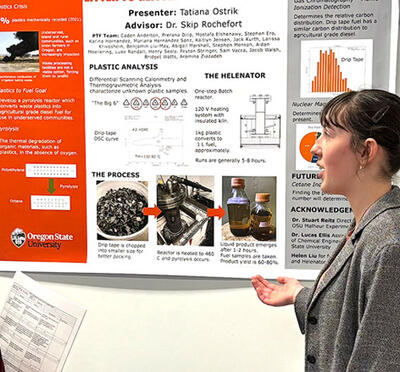Matthew Johnston is leading a quiet revolution in healthcare — one that fits in the palm of your hand.
Johnston, professor of electrical and computer engineering at Oregon State University, heads a lab focused on miniaturizing traditional lab equipment into portable, wearable devices.
“A lot of our focus is on taking big instruments — big boxes that would sit in a biology or chemistry lab — and trying to shrink those down,” Johnston said. “We use a variety of modern manufacturing technologies to make those much smaller so they can fit in the palm of your hand or even on your fingertip.”
This work is part of a broader movement toward at-home or wearable medical electronics — devices that can monitor health, diagnose disease, and even guide treatment, all without a trip to the clinic. The goal, Johnston says, is to increase accessibility and reduce costs.
Stretchable electronics to monitor the body
One of the most exciting areas of Johnston’s research is stretchable electronics — flexible, skin-like circuits that can be worn comfortably on the body. These devices are designed to monitor movement, track chronic conditions, and even interface with virtual reality systems.
The potential impact of this technology is enormous. Imagine a future where patients can monitor their hydration, glucose, and stress levels from a patch, or where a senior citizen can track their heart health with a soft, stretchable sensor embedded in their clothing. Johnston’s lab is working to make that future a reality.
Collaboration with clinicians and HP
But innovation doesn’t happen in isolation. Johnston’s team collaborates closely with researchers across disciplines — from bioengineering to artificial intelligence — and with clinicians to ensure their devices solve real-world problems.
“We collaborate a lot with people in our own department as well as in bioengineering for building new types of biosensors,” he said. “That often also involves collaborations with people in information processing, artificial intelligence, as well as clinicians, so that we are solving real problems with real clinical utility.”
One of the lab’s most fruitful partnerships is with HP, which has a major research facility in Corvallis. Together, they’re exploring how HP’s microfluidics and dispensing technologies — initially developed for inkjet printing — can be repurposed for life sciences.
“We’ve had an ongoing collaboration with HP,” Johnston said. “One facet of the collaboration involves cell counting, where we do cell analysis and counting of biological cells. It’s a natural connection point where our background and the things we can actually do in the lab are highly relevant to what their long-term goals are in the life science space.”
The collaboration serves as a model for how academia and industry can work together to accelerate innovation. HP brings manufacturing expertise and infrastructure; Johnston’s lab brings cutting-edge research and a deep understanding of biosensing and electronics. The result is a pipeline of technologies that could soon be commercialized and deployed in homes, clinics, and communities.
From bench to real-world apps…quickly
Johnston sees this kind of translation — from lab bench to real-world application — as the future of university research.
“We’re trying to solve problems that are identified by clinician partners or by community partners,” he said. “And we’re all playing a more active role now in translation—really getting these ideas, whether they’re new technologies or new algorithms, out into the world.”
That world is changing fast. The COVID-19 pandemic made at-home diagnostics mainstream, and Johnston believes we’re just scratching the surface.
“We’re all very familiar with the home COVID test,” he said. “But for a lot of applications, we really need a quantitative answer, not just a yes/no. Some of the technologies we’re working on would allow you to move that electronic readout directly into a low-cost, disposable product.”
From fingertip biosensors to AI-assisted diagnostics, Johnston’s work is helping to redefine what healthcare looks like — and where it happens.
“We have all of these tools now at our disposal that we can apply to really important problems in healthcare and medicine,” he said. “And hopefully, we’ll solve those problems much more rapidly.”




